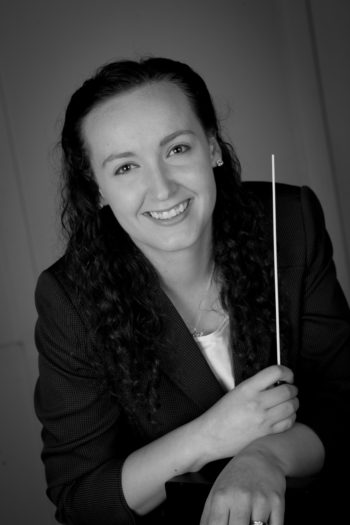
Editor, McLerran Journal
It is the goal of a professional musician to make playing an instrument or singing look effortless. This can only be achieved with years of intensive study and a well-developed ear. Teaching band and orchestra students how to sing will likely positively affect their aural skills, emotional health, confidence, and marketability.
What are aural skills?
Ear training is one of the most important aspects of music education since all musicians require the ability to hear and evaluate their performance. Individuals who select a music-related major in college will be required to take multiple semesters of an aural skills class (sometimes titled “sight-singing”) in order perfect their “inner-ear.” David Loberg Code from the Western Michigan University School of Music describes aural skills studies as “a means of developing crucial musicianship skills.” He elaborates that the four main goals of this course are to enable students to understand what they hear, to hear what they see, to make corrections, and to better internalize music. It is necessary for music educators to first be able to look at a score and predict how it is supposed to sound in order to “detect and correct discrepancies” in rehearsals (Code, 2011), just as a professional performer must be constantly checking and re-checking their tuning and accuracy. Professor Code shares that singing is beneficial because of its ability to strengthen one’s “inner performance” with “something concrete and physical.”
Creston Herron, Director of the award-winning Klein High School Orchestra (Klein, TX), believes that “kids will play as well as you expect them to” and that regular singing exercises help “to internalize pitch and improve aural skills.” These two musical concepts, he described as “equally important as the kinesthetic part of playing an instrument.” Herron explained that when students “understand what their function is” (within the harmonic structure), they are more likely to listen to the whole chord across the ensemble, rather than focusing only on their individual playing. Debbie Martin, the music instructor at Canyon Creek Elementary School (Austin, TX), also agrees that “instrumentalists who can sing on pitch are much more likely to play their instrument in tune” and requires all of her K-5 students to learn to use their voice. She also points out the benefits of learning proper posture, breath support, and how to balance with others through regular ensemble singing; three additional skills employed by all musicians.
Additional Benefits of Singing
Besides developing a stronger “inner ear,” singing in class also supports students’ emotional development and leads to more confident musicians. Stacy Horn of Time magazine cites a 2005 study that yielded the conclusion that, regardless of tone quality, ensemble singing “can produce satisfying and therapeutic sensations” that may alleviate the effects of anxiety or stress. Horn cites several instances where researchers have examined the release of various anti-stress hormones, like oxytocin and endorphins, that occurred during a vocal performance. Oxytocin is a hormone that controls elements of the reproductive system and multiple human behaviors including recognition, trust-building, and management of anxiety (Society of Endocrinology, 2015). Endorphins are neurotransmitters, or “brain chemicals,” which “function to transmit electrical signals within the nervous system” (Stoppler, 2018). Once released, these chemicals act to alleviate feelings of pain or stress and can also boost the immune system.
In a 2017 study completed by Nicola Swain (Dunedin School of Medicine, New Zealand) and Sally Bodkin-Allen (Southern Institute of Technology, Invercargill), it was determined that a positive correlation exists between regular participation in vocal performance and increased self-confidence. For the purposes of the experiment, forty music educators who “self-identified as uncertain singers” were asked to regularly participate in either Acceptance and Commitment Therapy (ACT) or group singing (Swain, Bodkin-Allen). While both therapies resulted in “significant improvements in singing confidence,” the group singing method “outperformed ACT on an overall rating of improvement in self-perceived tone-deafness” (Swain, Bodkin-Allen, 2017). Martin shares that singing is perhaps a superior form of therapy or community-building, since “you can do it anywhere and any time” without any equipment or cost. She uses regular voice-training to encourage her students to express their feelings and “be confident in their voices” and themselves.
Teaching instrumentalists to sing also enhances their marketability, should they choose to pursue music as a career. Skilled instrumentalists can make themselves more desirable to future college programs and employers by developing basic vocal abilities. In recent decades, there has also been a noticeable movement towards instrumental compositions that include a vocal or auxiliary part. More often, all levels of band students are expected to sing, snap, clap, or stomp in regular concert repertoire. Examples of this rising trend include Agincourt Hymn by Daniel Bukvich, Echoes of the Morning Trumpet by John Prescott, and Purgatorio by Robert W. Smith. It is our responsibility, as educators, to properly equip our students for a career in music and give them a myriad of tools to make them as distinguishable from their peers as possible.
Implementing a Vocal Routine
Several directors of instrumental ensembles are hesitant to introduce singing into their classrooms for a variety of reasons; limited rehearsal time, doubts about the validity of singing lessons to instrumentalists, or a lack of confidence in their own abilities. However, Melodianne Mallow, a distinguished clinician at the 2017 Texas Bandmasters Association Convention, said it best when she emphasized that directors “don’t have the time not to” teach strong fundamentals from the very beginning; ear training and self-awareness must be a priority for all levels of musicians.
In my own limited teaching experience, getting beginner band students to sing has taken very little convincing and has yielded musicians with heightened self-awareness, especially when it comes to tuning. Over the course of the school year (their first in band), I make it a point to have students periodically hum the tuning note (concert F) for intervals in between playing it. As the band’s warm up exercises become more advanced (for example, the Remington exercise), they are asked to hum more complex patterns of notes. It is important to explain to students regularly that, in order to achieve the highest level of musicianship, it is necessary to engage as many parts of the brain as possible during practice; getting them into the mindset that singing is something all musicians do.
About getting his high school orchestra students to sing, Mr. Herron shared that, assuming the students studied pitch-matching and solfege in elementary music, “you’re tapping into pre-existing knowledge (and an existing comfort level)” by employing these lessons in the ensemble setting. As part of their daily warm up, Herron requires his students to sing their major scales with the proper solfege (and coordinating hand signs) in thirds. The main focus of this exercise is tuning and a clear understanding of the function of each pitch within a chord. Herron also puts great emphasis on having clear intentions when it comes to phrasing and style, saying, “students will play it how they sing it.” Klein orchestra students are required to learn the words to a work or assign a plot to pieces without lyrics. Herron believes that “words add imagery” which can make determining phrase endings or studying a new style more accessible.
At the elementary level, Ms. Martin explains that she uses a significant amount of echo singing and repetition to get students started. She employs the Kodaly Concept (http://kodaly.hu/zoltan_kodaly/kodaly_concept) which introduces the use of solfege in accessible intervals and becomes increasingly more difficult “when students are developmentally ready.” She reminds educators that the most important thing “is to make singing fun and to allow students to build confidence in their voices by using singing games and activities that encourage them to love and appreciate making music.”
Sources
Code, David Loberg. (2011). Aural Skills Guide. Western Michigan University, College of Fine Arts, School of Music. Web. 2 March, 2018. <https://wmich.edu/mus-theo/etg/why.html>
Interview with Creston Herron. Director of the Klein High School Orchestra. Klein Independent School District. Klein, TX. 25 March, 2018.
Horn, Stacy. (2013). Singing Changes Your Brain. Time Magazine. Time, Inc. Web. 2 March, 2018 <http://ideas.time.com/2013/08/16/singing-changes-your-brain/>
Interview with Debbie Martin. K-5 Music. Canyon Creek Elementary School. Round Rock Independent School District. Austin, TX. 21 March, 2018.
Society for Endocrinology, United Kingdom. (2015). Oxytocin. Web. 11 March, 2018 <http://www.yourhormones.info/hormones/oxytocin/>
Stoppler, Melissa Conrad. M.D. (2018). Endorphins: Natural Pain and Stress Fighters. MedicineNet. Web. 11 March, 2018. <https://www.medicinenet.com/script/main/art.asp?articlekey=55001>
Swain, Nicola. Bodkin-Allen, Sally. (2017). Developing singing confidence in early childhood teachers using acceptance and commitment therapy and group singing: A randomized trial. Research Studies in Music Education. Vol 39, Issue 1, pp. 109 – 120. Web. 24 March, 2017. <http://journals.sagepub.com/doi/abs/10.1177/1321103X17700141#articleCitationDownloadContainer>














